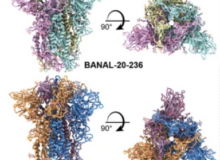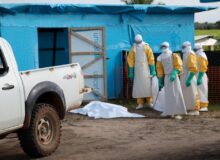Jonathan Latham and Allison Wilson (Photo Credit: Yodod)
Is it unrealistic to expect the scientific approval process for the world’s first commercial genetically engineered (GE) animal, the AquAdvantage salmon, to be rigorous and complete? Or for the applicant to present experiments that fully meet regulatory expectations? If you expect these things, it seems, you expect too much. Despite the biotech industry’s “dedication to rigorous science-based risk assessment”, the science of the AquAdvantage salmon is full of holes. Its maker, AquaBounty Technologies, has failed to provide key data on which the safety assessment process depends.
The US Food and Drug Administration (FDA) is currently considering whether to approve this salmon for sale to US consumers. If it becomes the world’s first commercial GE animal, the approval of the AquAdvantage salmon, which contains a modified growth hormone gene, will be a technological and cultural milestone. In perhaps as few as 18 months, if AquaBounty has its way, unlabeled GE salmon will be landing on the plates of consumers. So it is a fish that needs to be safe, for the public, as well as for the environment.
Congress has determined that GE animals will require FDA approval and that approval should be based solely on science. Science-based regulation is a narrow ground on which to base societal acceptability but its advantage is that, in principle, it allows the approval process to be orderly, data-based, and transparent, with requirements set out in advance (FDA’s industry guidance). There is, therefore, no good reason for an applicant to come to the table with shoddy science or missing data. However, that is what AquaBounty has done. This is a problem, in particular for the FDA, if it wishes to ensure that the approval process for the world’s first GE animal does not set an embarrassing precedent.
Key Publication Errors
The only peer reviewed publicly available data for assessing the science behind the AquAdvantage salmon is a single paper: Characterization and multigenerational stability of the growth hormone transgene (EO-1alpha) responsible for enhanced growth rates in Atlantic salmon (Yaskowiak et al. 2006). This article, researched and written by AquaBounty scientists, appeared in the scientific journal Transgenic Research in 2006. As it is AquaBounty’s sole publication on the AquAdvantage salmon, one might imagine, given its importance, that AquaBounty would have taken particular care to ensure its credibility and accuracy. It is surprising, therefore, to discover that the paper contains basic errors that prevent the reader from checking the author’s conclusions.
These mistakes can be summarised as follows: the legend for figure 1 (a Southern blot) wrongly identifies two lanes, and the transgene construct itself is mislabeled. In figure 5, the data showing the DNA sequence of the inserted transgene is entirely mangled. In this figure, two separate errors omit sequence stretches adding up to thousands of base pairs. A third error results in a long stretch of sequence being copied multiple times. In addition, the figure legend includes a typo. These errors are described in more detail in a footnote1.
These mistakes mean that the data presented in the paper contradict its written conclusions regarding the nature of the integrated transgene (Yaskowiak et al. 2006). The errors in figure 5 were later corrected in an erratum (Yaskowiak et al. 2007), but readers are still left to decipher figure 1 for themselves.
Has AquaBounty Identified the Right Transgene?
The primary purpose of a scientific paper (assuming the data have been presented accurately) is to allow the reader to verify that the data support the conclusions that are drawn. Yaskowiak et al. claim to have reached two fundamental conclusions: 1) that Aquabounty has created a GE salmon containing a single growth hormone transgene and 2) that this transgene is inherited stably through four generations. Of these two conclusions, the first, that there is a single insertion of the growth hormone gene, is never definitively established in the paper (nor anywhere else)2 and the second depends on the first.
In the paper, Yaskowiak et al. provide reasonable evidence that at least the transgene promoter is present as a single copy. They further claim to have evidence (data not shown) that the downstream regulatory sequence is present only as a single copy. However, the authors never use as a molecular probe the all-important growth hormone sequence itself. Consequently, their conclusions that extra copies or fragments of the growth hormone transgene are not present, and further, that the transgene they do analyse (which they call EO-1alpha) is responsible for the fish’s growth phenotype, are both dependent on extrapolation from the detection of regulatory sequences rather than detection of the gene itself. AquaBounty’s experiments, therefore, leave open the possibility that there are additional undetected copies of the growth hormone gene linked to the insertion site3.
Aquabounty Fails to Characterise the Transgene Insertion Site
AquaBounty also claims to have characterised the site of insertion of EO-1alpha. The basis for this claim is identification of repeated DNA sequences (that are similar to each other) flanking the EO-1alpha transgene. There are many weaknesses in this claim. For a start, the authors cannot say how much DNA has been lost during transgene insertion or whether the DNA sequences they identify as flanking the transgene were originally found at that genomic location, or even whether they originate from the salmon genome at all. A definitive description of the insertion site would show this, but this description can only be obtained by sequencing the wild-type (non-transgenic) copy of the genetic locus for comparison. AquaBounty does not have this information and so all of AquaBounty’s assertions regarding the insertion site are necessarily guesswork.
The possibility that large pieces of salmon genomic DNA may have been lost from the insertion site, or rearranged, is acknowledged by the FDA in its report to the Veterinary Medicines Approval Committee (VMAC). In this report, however, the FDA assumes (i.e. guesses) that any sequences lost were “nonessential”. Considering that the entire purpose of transgene insertion site analysis is to establish definitively, by the gathering of data, just this kind of fact, this is quite an assumption.
A consequence of incomplete scientific assessment is assumption-based reasoning
This analysis of the science of AquAdvantage Salmon raises a host of questions. For example, what happened to the peer review process at the journal Transgenic Research4? Why does AquaBounty stop short of establishing that there is only one growth hormone gene, and again fail to establish conclusively that there is limited genetic damage from the insertion? Is AquaBounty simply cutting corners, or do they have something to hide?
The most pertinent issues, however, are arguably for the FDA, since it is the federal agency charged with protecting the public. First, inadequate molecular characterisation means that there is no definitive description of the transgenic event contained in the AquaBounty Salmon. The FDA, ultimately, does not actually know what it is being asked to approve.
Secondly, without an accurate molecular characterization of the insertion site, the effectiveness of the approval process is compromised. For example, the phenotypic analysis of the AquAdvantage salmon is weak (FDA’s report to the VMAC). VMAC justifies this weakness in part by proposing (without presenting any supporting data) that a simple insertion site implies a low probability of unanticipated consequences (FDA’s report to the VMAC). Since the simplicity of the insertion site was never actually established, this is a hypothesis that rests entirely on assumptions and not data.
Thirdly, although the FDA has not reached a final decision, it is believed to consider that labeling of the AquAdvantage salmon is unnecessary because it is not “materially” different to a wild-type salmon. As a Biotechnology Industry Organization representative put it in the Washington Post “Extra labelling confuses the consumer because it differentiates products that are not different”. To be credible, this logic presupposes that someone qualified has actually looked for differences and not found them. Characterisation of the insertion site is the first and most basic step in this process. AquaBounty and the FDA have bypassed this scientific hurdle and settled for assumption-based reasoning.
Perhaps it was the same entrepreneurial spirit that motivated Congress to determine that ethics, morals and wider socioeconomic questions should be left out of the GE approval process, that also motivated the FDA to decide that they could leave out the science as well?
A Meaningless Standard?
This analysis has demonstrated basic weaknesses in the scientific support for any approval of AquaBounty’s AquAdvantage salmon. One could make yet more assumptions and argue that these lapses are unlikely to have serious consequences in the real world. For example, even if there is another growth hormone transgene present, it is not probable that it would affect food safety or the environmental consequences of an AquAdvantage salmon escape. However, it is our opinion, with so little data available about this salmon, that any such conclusion is grossly premature. Moreover, as the Consumer’s Union comments to FDA show there are in fact good grounds to be concerned about the safety of this fish.
One conclusion that can be reached, however, is an important procedural one: the AquaBounty application clearly does not meet the scientific stipulations of FDAs guidance document. The guidance document requests “the number and characterisation of the insertion sites…[defined as] the genomic location in the GE animal” and goes on to say “We consider this component critical” and even later “You should fully characterize the final stabilized rDNA construct” (FDA’s guidance for industry). Given this wording, it is surprising that the FDA has interpreted AquaBounty’s data as being more than sufficient.
As the very first application for a GE animal, the FDA’s response to the AquAdvantage salmon sets a precedent. It must now decide whether it wishes to stand by its original science-based guidelines or approve the AquAdvantage salmon. FDA’s response will be interesting because this salmon is attracting a lot of attention. This is not just because the AquAdvantage salmon is a GE animal, and not just because most other commercial GE organisms are animal fodder or ingredients for processed food. The probable explanation of why this salmon is a prominent topic of conversation is that salmon is the meat of choice of a significant and well-connected social grouping: well-educated consumers who consider themselves health-conscious.
In our complex world, where the political messages coming from national capitals are either mixed or manipulated, voters search for bellwethers, actions that give simple and clear clues to their leaders’ inclinations and intentions. Approval without labeling of the AquaBounty salmon would send a very clear message and might just turn out to be an unexpectedly big political mistake for the Obama administration.
Footnotes:
(1) The first data figure (Southern blot; Fig 1b) describes a Southern blot analysis designed to determine the number of copies of the transgene integrated into the salmon genome. There are seven lanes on the blot, including the marker lane. The second and third lanes are labeled incorrectly. Lane 2 is mislabeled as lane 3 and lane 3 (the second data point) is mislabeled as lane 2. This error can be spotted by logic alone: DNA cut by two enzymes cannot possibly be longer than DNA cut by one, when one of the enzymes is the same. The labeling mistake therefore should have been easy to spot. Further errors are found in figure 5. Figure 5 depicts the sequence data confirming the analysis of the transgene insertion site. We identified three separate mistakes in this figure: (a) except on the first page of figure 5 (page 471), the last two base pairs of every line of sequence are missing. Over six pages this adds up to 476 base pairs, i.e. two out of every fifty base pairs; (b) the sequence extending from base pairs 2618 to 3267 (using the numbering of the transgene itself) is quadruplicated, meaning the exact same data (this time 1,950 base pairs) appears four times within figure 5; and (c) Towards the end of figure 5, 7,653 base pairs, starting just after the growth hormone coding sequence are missing entirely. Both figures also contain “typographic errors”. The transgene construct, for example, is mislabeled once in figure 1. The errors in figure 5. (but not those in figure 1) are the subject of a nine-page erratum published subsequently (Yaskowiak et al. 2007).
(2) The possibility of extra copies is not idle speculation. Other authors have identified complex multiple transgene insertion events in salmon (Uh et al. 2006).
(3) There is unlikely to be an unlinked transgene since the AquAdvantage salmon has been backcrossed six times.
(4) Transgenic Research is a journal that frequently publishes self-evaluations and risk assessments of corporations’ own products.
References
Uh, M. Khattra, J. and Devlin, R.H. (2006) Transgene constructs in coho salmon (Oncorhynchus kisutch) are repeated in a head-to-tail fashion and can be integrated adjacent to horizontally-transmitted parasite DNA. Transgenic Research 15: 711-727.
Yaskowiak E.S., Shears, M.A., Agarwal_Mawal A., and Fletcher, G.L. (2006) Characterization and multigenerational stability of the growth hormone transgene (EO-1alpha) responsible for enhanced growth rates in Atlantic Salmon. Transgenic Research 15: 465-480.
Yaskowiak E.S., Shears, M.A., Agarwal-Mawal A., and Fletcher, G.L. (2007) Erratum to Transgenic Res. DOI: 10.1007/s11248-006-0020-5.




